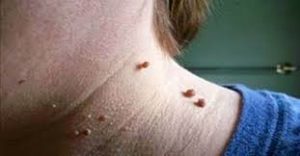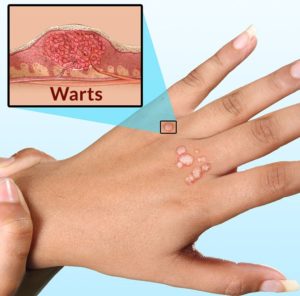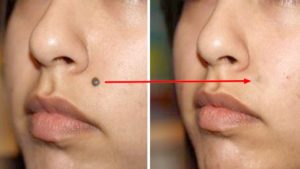Warts
Warts are growths of the skin that are caused due to infection by a virus. Warts can occur anywhere on the body.
Causes of Warts
The main cause of warts is infection of the top layer of the skin by the HPV or human papilloma virus. Warts are contagious and can spread to other areas of the body and also to other persons by direct by contact. The virus thrives in the damp, warm environment of the locker room floors, showers and swimming pools.
The risk of getting warts increases if:
You have broken skin
You have a hangnail
You have a closely bitten nail
Symptoms of warts
There are various types of warts and symptoms depend on the type and location of wart.
Common warts: They are rough, dome shaped, grey brown colored growths and usually develop on the hands.
Plantar warts: Develop on the foot, they make walking painful.
Flat warts:They usually occur on the arms, face or legs. Flat warts are small and multiple warts are present in any one area. Their tops are flat and their color ranges from pink to light yellow to light brown.
Filiform warts:They are a type of flat wart, which is present around the nose, mouth or beard area. There are many finger shaped and flesh colored growths present on the surface of these warts.
Periungal warts:These warts are present beneath and around the fingernails and toenails. They look like irregular, rough bumps.
Diagnosis of warts
Warts are diagnosed by a physician or a dermatologist on the basis of their appearance. A biopsy may be done in cases where the risks of developing skin cancer are increased.
Treatment of warts
Treatment is not required for all warts. Some of them go away on their own within several months or years. A wart requires treatment in case it is causing pain and embarrassment due to its location, gets irritated easily or spreading to other areas of your body.
The aim of treatment is to remove the wart without scarring. The treatment depends on the type, location and symptoms of a wart.
You can apply Salicylic acid or duct tape to your warts to treat them. If the wart does not go away within 2 weeks, seek the opinion of a physician. Your doctor may recommend the following to treat warts:
- Cryotherapy
- Medicines including cantharidin, retinoid cream and imiquimod
- Surgical procedures including laser surgery and electrosurgery and curettage
- Chemical peeling using tretinoin or glycolic acid.
How to prevent warts ?
Various tips to avoid getting in touch of the HPV virus include:
Avoid touching of warts
Avoid sharing of towels, razors, socks or shoes
Avoid walking barefoot on surfaces that are warm and moist
Avoid keeping your feet wet
Avoid injury to the soles of your feet
A skin mole is usually round or oval in shape and appears as a spot on the skin. The skin mole can be small or large. Its colour ranges from pink, brown, red, to black. Medically, the skin mole is also called as a nevus. Every human being is born with moles some have a few some many. They are located anywhere in the body. They are visible as dark spots as one ages.
Mole Removal
Moles are removed for cosmetic as well as medical reasons.
The treatment will consist of cauterizing the growth and immediate removal of the growth of mole.
Radio frequency is used to allow required magnitude of electric current to pass which will void the growth of any blood supply allowing it to be safely removed.
Radio frequency (Electrocautery) for wart & Mole removal
Radio frequency is ablative technique .
Radio frequency is used in the removal of skin lesions.This includes
1.skin tags
2.warts
3.seborrhoeic kerratosis(age or wisdom spots)
4.syringoma(harmless tumors within sweat glands)
5.melanocytic naevi(moles)
6.milea
OTHER USES
- cholesterol marks on eye.(xantholoma)
- skin tagging with pelleve.
ADVANTAGES
- Rapid Healing
- Minimal or no Bleeding
- Aesthetically pleasing scars or no scars
- Shorter operating time
CONTRAINDICATIONS
- PREGNANT AND BREAST FEEDING
- CARDIAC PACE MAKER
- DIABETES
- KELOID


